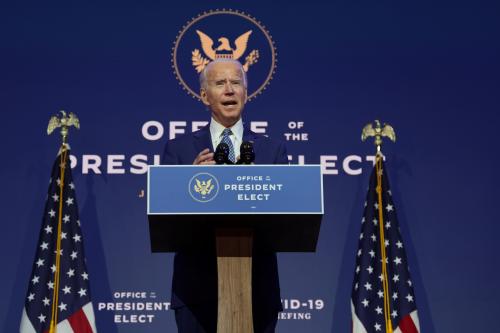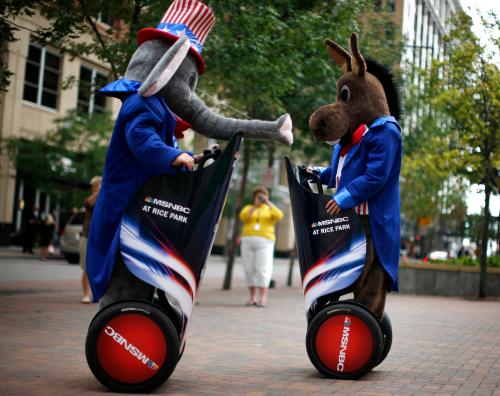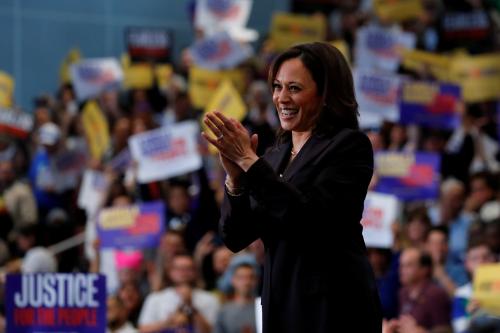The inevitability of generational transition looms over the Democratic Party, as was evident on the second night of the Democratic convention. Former President Bill Clinton represented the party’s past, 2020 presidential nominee Joe Biden its present, and Representative Alexandria Ocasio-Cortez its possible future.
If a relative handful of votes had fallen differently in 2016, Bill Clinton would have been speaking on behalf of President Hillary Clinton’s reelection campaign. Instead, he offered a pointed critique of the man who defeated his wife and brought the Clinton era to an end. The man from Hope built a well-organized case on behalf of the party’s present: Joe Biden’s campaign to turn Donald Trump out of office after a single term. In terms reminiscent of his own 1992 promise to “put people first,” Bill Clinton characterized Biden’s agenda as bold but sensible, reformist rather than revolutionary, a source of continuity in turbulent times.
In the surprise of the evening, Colin Powell threw his considerable gravitas behind Joe Biden’s presidential campaign on Tuesday night, and Cindy McCain was there to remind us of a time, also in history’s rear-view mirror, when relationships among elected officials such as the deep friendship between Biden and her late husband transcended party lines. These appearances were important symbols of the breach between the former Republican establishment and today’s Trump-dominated GOP.
If Joe Biden is elected president, he will be the oldest person ever to occupy the office—older the day he enters the presidency than Ronald Reagan was the day he left it. He is the present of the Democratic Party, not its future—a self-described transitional figure. Represented endearingly by his wife Jill, Joe Biden stood out as decent, thoroughly normal, and slightly old-fashioned.
And finally, there was the much-anticipated speech by the young congresswoman from New York, Alexandria Ocasio-Cortez, who made a bid to claim the party’s future. Tellingly, she spoke not of the party but of the movement she helps lead to create a 21st Century progressive agenda—green, unabashedly multiethnic, focused on economic, social, racial and environmental justice—and her desire to move it to the center of American public life. Tuesday night’s opening 17-person keynote address seemed designed to reinforce these themes, as did the convention’s innovative roll call.
The nominee of the Democratic party is 77 years old. Its three most senior leaders in the House of Representatives are all in their 80s. When the next Senate convenes, the current Democratic leader and whip will be in their 70s. By the middle of this decade, most of the party’s leaders will be new. But it is not clear whether they will be drawn mostly from the generation in their 50s and 60s which has patiently waited its turn, or from the very different generation in their 30s and 40s, more diverse than their predecessors and palpably impatient to take charge.
More than chronology is at stake. With Joe Biden’s careful bridge-building, the Democratic Party has come back together after the deep divisions of four years ago. But today’s unity is more a truce than a final peace. If Joe Biden is elected president, the party’s progressives will pull in one direction, the center-left in another. In many cases, the issue will not be the direction of change but rather the pace and scope of change. In some, the disagreement will involve basic principles. The Democratic Party either believes in defunding the police or it doesn’t. This dispute isn’t just a matter of dollars appropriated; it raises deep questions about the nature of American society.
This is nothing new, of course. The United States has the minimum number of major political parties a representative democracy requires. In a heterogeneous nation of 330 million people spanning a continent, each of these parties is likely to be a fractious coalition.
But the stakes are higher than usual. Beneath the urgent crises of the present, the United States is poised uneasily between its past and its future. The tectonic plates that have been locked in place for the past three decades are bound to shift abruptly; too much energy has built up along the fault-line for the status quo to last much longer. So long as Republicans take their bearings from a vanished past, the Democratic Party seems destined to be the arena within which the contours of the future are debated.







Commentary
How the Democrats are trying to bridge the party’s past and future
August 19, 2020